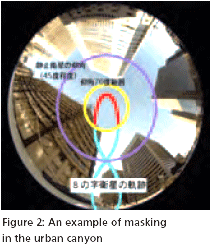| GNSS | |
A yen for regional navigation
Option B: QZSSThe Quasi-Zenith Satellite System (QZSS) option is actually the first phase of JRANS, as mentioned above, three satellites in quasizenith orbit (Figure 1). In June 2002, the GOJ’s Council for Science and Technology Policy of the Cabinet Office gave the go-ahead to begin working on QZSS research and development. The government role can be classified as research and development. The plan is to design and develop the first three QZSS satellites and the budget (US$52M in FY2003 and US$77M in FY2004) hasbeen approved respectively. Several Japanese government agencies are involved in this fi rst phase, to include: • MEXT (Ministry of Education, Culture, Sports, Science and Technology): Experimental satellite positioning technology • MIC (Ministry of Internal Affairs and Communications): Precise timing control and communication • METI (Ministry of Economy, Trade and Industry): Key technologies for advanced satellite bus • MLIT (Ministry of Land, Infrastructure and Transportation): High-accuracy DGPS augmentation system A notional QZSS development schedule has been prepared and is expected to be used for planning and budgeting purposes. Overall, the GOJ is planning to invest approximately JPY50B (US$430Mn) in research and development funding for QZSS during the period 2003- 2009. The notional schedule is: • FY 2003: Definition Phase (US$50Mn budget approved) • FY 2004: Research & Development Phase (US$74Mn budget approved) • FY 2005-2008: Engineering & Manufacturing Phase • FY 2009: 1st Satellite Launch From a commercial perspective, and in addition to the basic navigation functions that will be fully compatible with GPS, QZSS can provide communication services, broadcasting services and differential GPS services. In November 2002, in response to these commercial opportunities, Japanese industry jointly formed the Advanced Satellite Business Corporation (ASBC) to conduct the feasibility study for determining the opportunities of using QZSS to provide commercial services, such as S-band communications and broadcasting for mobile users. Current statusAs indicated in the previous section, the GOJ has committed resources to begin the design and development of a GPS-compatible Regional Satellite System capable of serving Japan as well as all of Asia. It is also evident that the design and development road will be lengthy without support from the US. Both Japanese government and industry recognize the importance of working cooperatively with US government and industry. As early as April 2002 at the CGSIC 39th meeting in Springfi eld, Virginia, ITOCHU and NTSpace have been making public presentations regarding Japanese planning efforts and opportunities for US-Japanese government and commercial cooperation. From a government-to-government perspective, on 22 September, 1998 a US-Japan GPS partnership was forged when President William Clinton and Prime Minister Keizou Obuchi issued a joint statement regarding cooperation in the use of the GPS standard positioning service. Taking the statement, USJapan GPS Plenary Meetings have been held to further harmonize joint activities. In addition, the Plenary agreed to form a Joint Technical Working Group to further the close cooperation between the US and Japan The Working Group goals are essentially to: • Assure maximum QZSS interoperability with GPS • Optimize the QZSS design to maximize GPS-QZSS performance in Asia • Increase commercial opportunities for GPS-QZSS applications Future outlook for AsiaGPS reliance cannot be denied; neither can the signifi cance of GPS for a broad spectrum of Asian users. In general, the aviation community appears to have a well established set of performance requirements for satellite-based navigation and are actively pursuing the development and implementation of civil augmentation systems. However, these “wide area coverage” augmentation systems: • US: Wide Area Augmentation Systems (WAAS) • Europe: European Geostationary Navigation Overlay System (EGNOS) • India: GPS/GLONASS and Geostationary Augmented Navigation (GAGAN) • Australia: Ground-based Regional Augmentation System (GRAS) All have one thing in common: the US GPS. If GPS signals “go away” then the utility of these augmentation systems will be close to zero. The Japanese government and industry personnel have carefully studied the significance of GPS on our daily lives, considered critical enabling issues, such as cost, time, GPS compatibility, additional business opportunities, and public/private ownership. A decision was made to move forward with a GPS-compatible regional system capable of providing independent, satellite-based position, velocity and time services while taking advantage of the broad range of benefi ts available from GPS signals and the current GPS industry. Most importantly for all of Asia, is that (in the near future) a combined US GPS and a standalone Japanese Regional Navigation Satellite System (RNSS) will provide a robust foundation for current and future generations of GPS users! |
||||||||||||
|
||||||||||||
|
Pages: 1 2















 (No Ratings Yet)
(No Ratings Yet)




